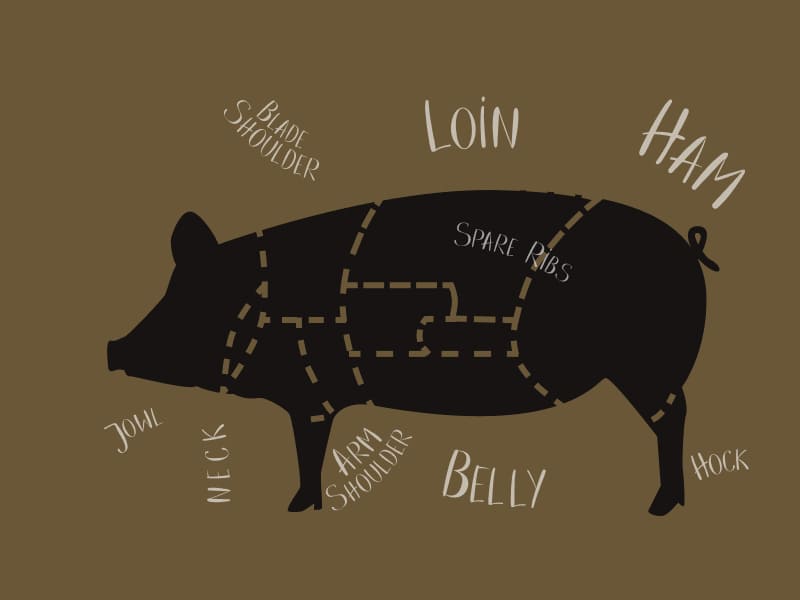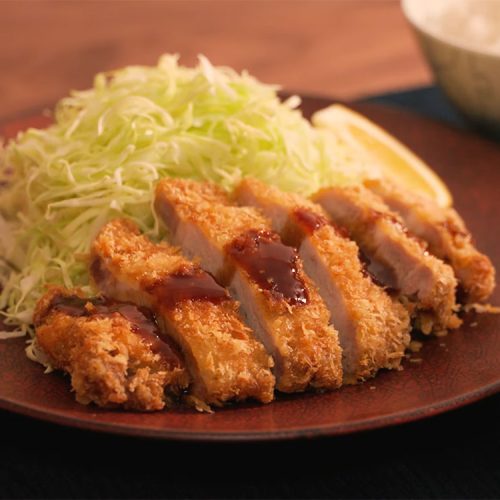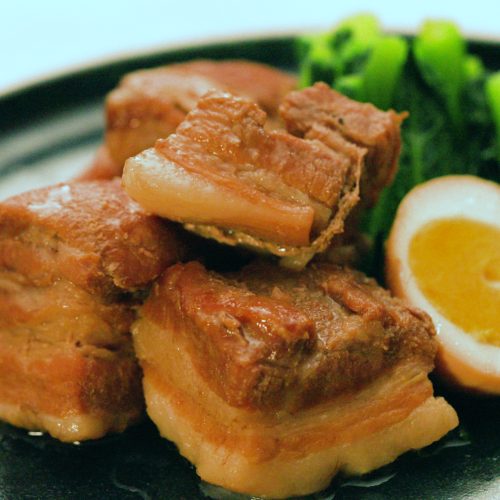- COLUMN
About the characteristics of the parts – Part2 – Porkology vol.4

“Porkology” introduces various information on pork from a nutritionist’s point of view.
In the 3rd~4th issue, we explain about the parts of pork.
In the third installment, we introduced the characteristics of major pork parts. In this fourth installment, we will focus on the minor pork parts that are difficult to obtain in large quantities, such as the hojo, neck, udes, shank, and pig’s feet, and delve deeper into the characteristics of these parts.
These five parts are rarely encountered in supermarkets, but they all have a unique flavor and are rich in nutrients, and should be utilized when you see them. By learning about these maniacal pork parts, you will be able to enjoy pork even more!
In addition, I will also introduce some local foods using pork, so please check them out!
Jowl

Only a very small amount of the meat is harvested from a single pig, making it a rare part of the pig. It is also called “komekami(コメカミ)” or “kashira(カシラ)” in Japanese yakitori restaurants. Jowl is low in fat due to its moderate mobility, and has a more muscular and elastic texture. To enjoy its unique texture, it is best to grill it. It is also suitable for long stews, and if you make it into a stew, you can enjoy even the broth in which the flavor has been dissolved. Because they lose their freshness quickly, they are not often found in supermarkets for general consumers. If you happen to see them, please give them a try in your cooking.
- Low fat and elastic texture
- Rich in zinc, collagen and calcium
- POPULAR RECIPES
- French bouillabaisse, Italian carbonara, pot-au-feu, stews, and ravioli are some examples. These are delicious dishes that maximize the flavor of pork cheeks.
Neck

Neck is the meat around the neck of a pig, also known as “ton-toro(トントロ=fatty pork)” in Japan. ton-toro is nowadays more and more common in yakiniku restaurants. The neck is a rare part of the pig, and only about 300 grams of the neck can be obtained per pig. It is a fatty part of the pig, so you can enjoy the full flavor and juiciness of the pork. The fatty meat has a melting texture that is very appealing, but it is also a part that can be enjoyed for its chewiness when grilled. It is high in fat and calories, so be careful not to overeat, but it is rich in nutrients. It is high in protein and contains B vitamins, iron, and zinc.
- Fatty and melt-in-your-mouth texture
- Rich in protein, iron and zinc
- POPULAR RECIPES
- It is used in a variety of dishes such as stews, braises, curries, grilled meats, and meatballs. It is a typical pork dish characterized by its rich flavor and texture.
Picnic

Picnic is the part of the front leg. It is characterized by its tight texture due to its well-muscled muscles. It contains little fat but a good amount, and its strong flavor makes it delicious. Because of its characteristic texture and deep flavor, picnic is valued in many dishes. Although it is leaner and the meat is somewhat tough, it can be tenderized by stewing it for a long time. Using picnic in stewed dishes makes the meat tender and tender. It is a part often sold in Japanese supermarkets in the form of cut meat, or minced meat. Because of its strong flavor, picnic can be used in stir-fried vegetables or pork miso soup.
- Tender with little fat
- Rich in zinc and collagen
- POPULAR RECIPES
- It is suitable for a wide variety of dishes such as stir-frying, stewing, cutlets, grilled meat, and shabu-shabu. Its flavorful and juicy characteristics can be enjoyed in a wide variety of dishes, from Japanese to international cuisines.
Shank

The shank is the meat at the tip of the pig’s leg. The meat is muscular and firm with little fat due to the development of muscles from walking. The flavor is unique and refreshing. In addition to its muscularity, another characteristic of shank meat is that it has a lot of muscle. When grilled as it is, its firmness stands out, but when braised, it becomes tender. The reason why the meat becomes so tender when it is stewed is due to the collagen that it contains in abundance. The collagen is dissolved in the meat as it is stewed, adding richness and depth to the dish. Brock tends to be used for dishes in which the shank is stewed for a long time. In addition to stews and simmered dishes, it is sometimes used in ramen soups. It is also sometimes used to make ground meat. It is also used in hamburgers because it clumps together easily, giving it richness and depth.
- Low fat and refreshing
- When simmered, the collagen dissolves and the richness and depth can be tasted.
- Full of collagen
- POPULAR RECIPES
- When stewed at low temperature for a long time, the meat becomes tender and flavorful, making it a perfect match for rich sauces. As an ingredient in stews and curries, it can be used to create dishes with a deep and satisfying flavor.
Knuckles

Knuckles is the leg of the pig, and refers to the tip of the leg further than the shank. The front leg, which is often moved, tends to have more lean meat, while the hind leg tends to have more fat. Originally eaten only in limited areas of Japan, such as Okinawa and Amami regions, it is now becoming popular throughout the country, and restaurants are now serving dishes made with pig’s feet. It is said to be suitable for stewed dishes, and when stewed for a long time, it becomes plump, which is because pig’s feet are rich in collagen. Pork feet are so rich in collagen that in some countries they are eaten as a beauty food. Another key point is that they are delicious not only in typical stewed dishes, but also when grilled. When grilled, the outside becomes crispy but the inside becomes tender, so you can enjoy the contrast of textures.
- Collagen is pulled out after a long simmering process.
- Delicious even when baked.
- Rich in collagen
- POPULAR RECIPES
- It is mainly used in soups and stews, where the unique texture of the cartilage and skin can be enjoyed. In Japan, it is stewed as “tonbo ni” (stewed pig’s feet), and stewed or grilled pig’s feet are popular in Chinese cuisine.
Pork is an ingredient used in many local foods (local cuisine)
Here we would like to introduce three local foods made with pork that are available in tourist destinations in Asia. Pork, which has different tastes and textures depending on its parts, supports local cuisines.
- Tebichi
- The first is tebichi, which is eaten in Okinawa Prefecture, Japan. When people in Japan hear the word “tebichi,” they immediately think of “stewed pig’s feet,” which is eaten in Okinawa. Originally, however, “tebichi” was not limited to pig’s feet, but any dish made of meat and stewed in soy sauce flavor was called “tebichi” in Okinawa. Therefore, the dish that most Japanese people think of when they hear the word “tebichi” is correctly called “tebichi (pig’s feet stewed in soy sauce).
- Khao Kha Moo
- The second is “Khao Kha Moo” from Thailand. Khao Kha Moo is a dish of pig’s feet stewed with octagonal horns and cinnamon and served over rice. In Thai, “khao” means rice, “kha” means leg, and “Moo” means pig. Although it contains spices, it is not spicy, so even those who do not like spicy food can enjoy it.
- Bak kut teh
- The third is “Bak kut teh,” a dish popular in Singapore and Malaysia. Bak kut teh is written in Chinese characters as “肉骨茶,” with “肉骨” meaning pork and “茶” meaning soup. It is a culinary soup dish made by stewing meat on the bone with garlic, Chinese herbs, pepper, and other spices, and is excellent when served over white rice with Bak kut teh soup.
As in the case of the three dishes introduced here, local foods made with pork are sometimes loved in popular tourist destinations. If you visit unfamiliar areas or countries for sightseeing, why not try some of the local foods made with pork?
“Porkology” focuses on pork itself. This time, we focused on the minor parts of pork and introduced the characteristics, taste, nutrients contained in each part, and dishes suitable for each. We hope you have learned that cooking pork in a way that is appropriate for each part makes it taste many times better. If you have a chance to try a part of the meat that you have never heard of before, please do so.
We look forward to seeing you again in the next issue!
Editor

MAKITA Yoshimi
Registered Dietitian
She has experience in product development and specific health guidance for a food service company.
In addition to her extensive field experience as a registered dietitian, she is involved in column writing and nutritional calculations.
She specializes in creating menus for people with health issues.










